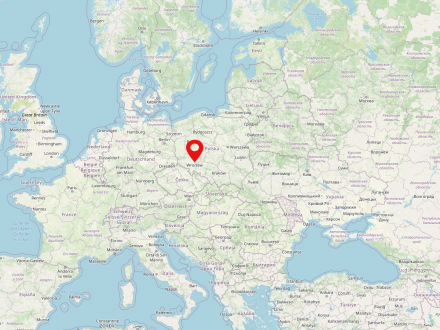Wrocław (German: Breslau) is one of the largest cities in Poland (population in 2022: 674,079). It is located in the Lower Silesian Voivodeship in the southwest of the country.
Initially under Bohemian, Piast and at other times Hungarian rule, the Habsburgs took over the Silesian territories in 1526, including Wrocław. Another turning point in the city's history was the occupation of Wroclaw by Prussian troops in 1741 and the subsequent incorporation of a large part of Silesia into the Kingdom of Prussia.
The dramatic increase in population and the fast-growing industrialization led to the rapid urbanization of the suburbs and their incorporation, which was accompanied by the demolition of the city walls at the beginning of the 19th century. By 1840, Breslau had already grown into a large city with 100,000 inhabitants. At the end of the 19th century, the cityscape, which was often still influenced by the Middle Ages, changed into a large city in the Wilhelmine style. The highlight of the city's development before the First World War was the construction of the Exhibition Park as the new center of Wrocław's commercial future with the Centennial Hall from 1913, which has been a UNESCO World Heritage Site since 2006.
In the 1920s and 30s, 36 villages were incorporated and housing estates were built on the outskirts of the city. In order to meet the great housing shortage after the First World War, housing cooperatives were also commissioned to build housing estates.
Declared a fortress in 1944, Wrocław was almost completely destroyed during the subsequent fightings in the first half of 1945. Reconstruction of the now Polish city lasted until the 1960s.
Of the Jewish population of around 20,000, only 160 people found their way back to the city after the Second World War. Between 1945 and 1947, most of the city's remaining or returning - German - population was forced to emigrate and was replaced by people from the territory of the pre-war Polish state, including the territories lost to the Soviet Union.
After the political upheaval of 1989, Wrocław rose to new, impressive heights. The transformation process and its spatial consequences led to a rapid upswing in the city, supported by Poland's accession to the European Union in 2004. Today, Wrocław is one of the most prosperous cities in Poland.
- on the basis of the diaries of Willy Cohn and Walter Tausk;
- using the example of Jewish residential home foundations and their 'Aryanization' as well as looking at the consequences for the residents;
- which were a a result of forced admissions to the Breslau 'Judenhäuser', where Jews had to live under the constant threat of being deported;
- which the Lower Silesia Regional Association of the Central Association of German Citizens of the Jewish Faith in Wroclaw countered through its efforts to defend Jews against comprehensive degradation by National Socialism.
- through the example of the history of the Jewish Theological Seminary Fraenckel'scher Stiftung from 1854 up until the Nazi era;
- by analyzing the history of the gap created by the destruction of the New Synagogue Am Anger on the night of the pogrom in 1938, which is considered a symbol of the extermination of Wroclaw's Jews;
- through the example of the history of the Jewish cemetery on Claassen Street/ul. Gwarna;
- through the example of the multiple social, legal and remembrance culture transformations of the New and the Old Jewish Cemetery.
- as exemplified by the radio media site (Silesian Radio Hour);
- through the example of the tense relationship between the Jewish community and Jewish architects;
- through the example of the Silesian Jewish art associations, museum and art collections.
- "invisible places" such as Jewish infirmaries and nursing homes;
- Jewish forced labor camps in Wroclaw ('extermination through labor');
- Collection points and train stations as local 'Holocaust landscapes';
- The disappearance of Wroclaw Jews and their sites from contemporary maps.
- in travel reports of Jewish journalists and testimonies of Shoah survivors 1946-1949;
- in the public space exemplified by the exhibition of the Recovered Territories in 1948 and the exhibition of rescued works by Jewish artists;
- through the analysis of Breslau places and memories in narrative interviews with surviving Breslau Jews in Israel ("Israel corpus");
- using the example of the holdings of the Arolsen Archives on the topic of researching the history of Wroclaw Jews, their persecution and extermination, and their survival.














